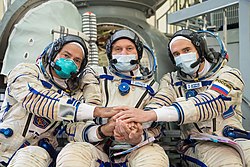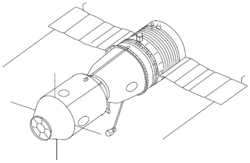Sojuz MS-18
| Sojuz MS-18 (Союз МС-18) | |||
| Beställare | Roskosmos | ||
|---|---|---|---|
| Modell | Sojuz-MS | ||
| Tillverkare | RKK Energia | ||
| Operatör | Roskosmos | ||
| Färdens tid | 190 dag, 20 tim, 53 min | ||
| NSSDC-ID | 2021-029A[1] | ||
| Uppskjutning | |||
| Startplats | Bajkonur 31/6 | ||
| Start | 9 april 2021, 07:42:41 UTC | ||
| Raket | Sojuz-2.1a | ||
| Landning | |||
| Landningsplats | Kazakstan | ||
| Landning | 17 oktober 2021, 04:35:44 UTC | ||
| Omloppsbana | |||
| Banlutning | 51,6° | ||
| Besättning | |||
| Start | Oleg Novitskij Pyotr Dubrov Mark T. Vande Hei | ||
| Landning | Oleg Novitskij Klim Shipenko Julia Peresild | ||
 | |||
| Dockning | |||
| Rymdstation | ISS | ||
| Dockning | 9 april 2021, 11:05:07 UTC | ||
| Port | Rassvet, nadir | ||
| Ur dockning | 28 september 2021, 12:21 UTC | ||
| Andra Dockning | 28 september 2021, 13:04 UTC | ||
| Port | Nauka, nadir[2] | ||
| Andra ur dockning | 17 oktober 2021, 01:14 UTC | ||
| Tid dockad | 190 dag, 13 tim, 26 min | ||
| Kronologi | |||
| |||
Sojuz MS-18 (ryska: Союз МС-18) är en flygning i det ryska rymdprogrammet, till Internationella rymdstationen (ISS). Farkosten sköts upp med en Sojuz-2.1a-raket, från Kosmodromen i Bajkonur, den 9 april 2020. Några timmar efter uppskjutningen dockade farkosten med rymdstationen.
Flygningen transporterade Oleg Novitskij, Pyotr Dubrov och Mark T. Vande Hei till rymdstationen.
Den 28 september 2021 flyttades farkosten till en dockning port på Nauka modulen.[2]
Den 17 oktober 2021 lämnade farkosten rymdstationen. Några timmar senare återinträdde den i jordens atmosfär och landade i Kazakstan.
För att säkerställa funktionaliteten på den amerikanska delen av rymdstationen, valde NASA att bytta en plats på en framtida amerikansk flygning till rymdstationen, mot en plats för en amerikansk astronaut på Sojuz MS-18.[3]
Besättning
| Uppskjutning | Landning | |
|---|---|---|
| Befälhavare | Hans tredje rymdfärd Expedition 64 / 65 | |
| Flygingenjör 1 | Hans första rymdfärd Expedition 64 / 65 | Hans första rymdfärd |
| Flygingenjör 2 | Hans andra rymdfärd Expedition 64 / 65 | Hennes första rymdfärd |
Reservbesättning
| Befälhavare | |
|---|---|
| Flygingenjör 1 | |
| Flygingenjör 2 |
Källor
- Den här artikeln är helt eller delvis baserad på material från engelskspråkiga Wikipedia, Soyuz MS-18, 3 april 2021.
Noter
- ^ ”NASA Space Science Data Coordinated Archive” (på engelska). NASA. https://nssdc.gsfc.nasa.gov/nmc/spacecraft/display.action?id=2021-029A. Läst 3 maj 2021.
- ^ [a b] ”Soyuz Crew Ship Docks to New Science Module Port” (på engelska). NASA. 28 september 2021. https://blogs.nasa.gov/spacestation/2021/09/28/soyuz-crew-ship-docks-to-new-science-module-port/?fbclid=IwAR0FPS4kughvaCAuqrQFIqL4vqaR6_bxPU_2pVYp2gq6e5in_VQx4-mR_o8. Läst 28 september 2021.
- ^ ”NASA Assigns Astronaut Mark Vande Hei to International Space Station Crew” (på engelska). NASA. 9 mars 2021. https://www.nasa.gov/press-release/nasa-assigns-astronaut-mark-vande-hei-to-international-space-station-crew. Läst 3 april 2021.
| |||||||||||||||||||||||||||||||||||||||||||||||||||||||||||||||||||||||||||||||||||||||||
| |||||||||||||||||||||||||||||||
| ||||||||||||||||||||||||||||||||
Media som används på denna webbplats
Soyuz-A manned spacecraft concept (1963). It was to have been part of the Soyuz A-B-C circumlunar complex.
Apollo-Soyuz Test Project (ASTP) Soyuz. The APAS-75 docking unit is located at left.
Soyuz-TM spacecraft. Compare the antennas on the orbital module to those on Soyuz-T. Differences reflect the change from the Igla rendezvous system used on Soyuz-T to the Kurs rendezvous system used on Soyuz-TM.
The Soyuz TMA-04M spacecraft is seen after being rolled out by train to the launch pad at the Baikonur Cosmodrome in Kazakhstan, May 13, 2012. The launch of the Soyuz spacecraft, with Expedition 31 Soyuz Commander Gennady Padalka, Flight Engineer Sergei Revin of Russia and NASA Flight Engineer Joe Acaba, is scheduled for 9:01 a.m., May 15 (Kazakhstan time).
Rotated and color enhanced version of original (ISS013-E-48788 (6 July 2006) --- The Space Shuttle Discovery approaches the International Space Station for docking but before the link-up occurred, the orbiter went through a series of inspection photos by station crew to inspect the vehicle for any damage to its Thermal Protection System. This was known as the Rendezvous Pitch Maneuver and was implemented after the Columbia Disaster in 2003. The Leonardo Multipurpose Logistics Module can be seen in the shuttle's cargo bay. Discovery docked at the station's Pressurized Mating Adapter 2 at 9:52 a.m. CDT, July 6, 2006.)
Backdropped by a blue and white Earth, this close-up view features the Soyuz TMA-6 spacecraft approaching the International Space Station (ISS). Onboard the spacecraft are cosmonaut Sergei K. Krikalev, Expedition 11 commander representing Russia's Federal Space Agency; astronaut John L. Phillips, NASA ISS science officer and flight engineer; and European Space Agency (ESA) astronaut Roberto Vittori of Italy. The Soyuz linked to the Pirs Docking Compartment at 9:20 p.m. (CDT) on April 16, 2005 as the two spacecraft flew over eastern Asia. The docking followed Friday’s launch from the Baikonur Cosmodrome in Kazakhstan.
In this illustration, a SpaceX Crew Dragon spacecraft approaches the International Space Station for docking. NASA is partnering with Boeing and SpaceX to build a new generation of human-rated spacecraft capable of taking astronauts to the station and expanding research opportunities in orbit. SpaceX's upcoming Demo-1 flight test is part of NASA’s Commercial Crew Transportation Capability contract with the goal of returning human spaceflight launch capabilities to the United States.
Författare/Upphovsman: Pascal (Flickr user: pasukaru76), Licens: CC0
Vostok spacecraft replica at the Technik Museum Speyer, Germany.
Expedition 64 backup crew members NASA astronaut Mark Vande Hei, left, Russian cosmonaut Oleg Novitskiy of Roscosmos, center, and Russian cosmonaut Petr Dubrov of Roscosmos pose for a photo during qualification exams Tuesday, Sept. 22, 2020 at the Gagarin Cosmonaut Training Center (GCTC) in Star City, Russia.


















